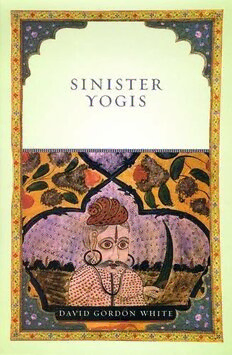Table Of ContentSinister Yogis
Sinister Yogis
DaviD GorDon White
The University of Chicago Press Chicago and London
DAVID GORDON WHITE is professor of religious studies at
the University of California, Santa Barbara. He is the author of several
books, including The Alchemical Body: Siddha Traditions in Medieval India
and Kiss of the Yogin¯ı: “Tantric Sex” in Its South Asian Contexts, both
published by the University of Chicago Press.
The University of Chicago Press, Chicago 60637
The University of Chicago Press, Ltd., London
© 2009 by The University of Chicago
All rights reserved. Published 2009
Printed in the United States of America
18 17 16 15 14 13 12 11 10 09 1 2 3 4 5
ISBN-13: 978-0-226-89513-0 (cloth)
ISBN-10: 0-226-89513-0 (cloth)
Library of Congress Cataloging-in-Publication Data
White, David Gordon.
Sinister yogis / David Gordon White.
p. cm.
Includes bibliographical references and index.
ISBN-13: 978-0-226-89513-0 (cloth : alk. paper)
ISBN-10: 0-226-89513-0 (cloth : alk. paper) 1. Yogis—India—
History. 2. Yoga. I. Title.
BL2015.Y6W55 2009
294.5’61—dc22
2009004546
a The paper used in this publication meets the minimum require-
ments of the American National Standard for Information Sciences—
Permanence of Paper for Printed Library Materials, ANSI Z39.48-1992.
Contents
List of Illustrations vii
Preface ix
Note on Transliteration xvii
Abbreviations xix
1 Tales of Sinister Yogis 1
2 Ceci n’est pas un Yogi 38
3 Embodied Ascent, Meditation, and Yogic Suicide 83
4 The Science of Entering Another Body 122
5 Yogi Gods 167
6 Mughal, Modern, and Postmodern Yogis 198
Notes 255 Bibliography 303 Index 337
Illustrations
Cover Nāth Yogī, wall painting from the haveli of Sukhdev Das
Ganeriwala
1.1 Bhairavānand Yogī chapbook cover 5
1.2 Bherūṃ-jī and seven sisters, women’s wedding necklace 11
2.1 Mohenjo-Daro clay seal 420 49
2.2 Śrī, Bharhut railing medallion 50
2.3 Obverse of copper coin of Indo-Scythian King Maues 51
2.4 Sculpture of Artemis of Ephesos, Caesarea, detail
of robe 52
2.5 Celtic horned god Cernunnos, detail from inner panel of
Gundestrup Cauldron 53
2.6 Seated prince or bodhisattva 56
2.7 Obverse of double stater of Kushan emperor Vima
Kadphises 57
2.8 Reverse of tetradrachma of Kushan emperor Kaniṣka 58
2.9 Hero Stone (vīragal) portraying apotheosis of a slain hero
on a heavenly chariot 66
2.10 Sculpture of Lakulīśa seated on a lotus 80
3.1 Detail of western mural at Lukhang Temple, Tibet 87
3.2 A ray from the sun ignites the pyre of Sarasvatī Satī 119
4.1 Yogī Macchindranāth and his disciples 152
5.1 Lokapuruṣa (Cosmic Being) 174
5.2 Cosmic body of a yogi, based on the Siddhasiddhāntapaddhati 176
5.3 Kṛṣṇa displays his Universal Form 184
5.4 Four yoga-born sons of Brahmā depicted as yogis 187
6.1 Detail of a lithograph showing an underground crypt 206
6.2 Nāth Yogī tumuli in Kathmandu 207
6.3 Detail of a lithograph showing Indian Fakirs 213
6.4 Nāth Yogī, wall painting from the haveli of Sukhdev Das
Ganeriwala 221
6.5 A yogi spy in a detail from the illustrated manuscript
Hamzanama 227
viii
Preface
Like most of the buildings around it, the Trader Joe’s super-
market in West Hollywood is a low-slung pastel affair with
a parking lot in the back. For a time during the winter and
spring of 2007, the parking lot attendant there was an el-
egant beturbaned Sikh who seemed to be engaged in urgent
conversations on his cell phone every time I shopped there.
But one day, the Sikh was absent and another person wear-
ing a turban—someone far shorter and chubbier and with an
unkempt beard—was standing in the lot. This person walked
up to me as I was about to enter the market and said that he
could tell by the lines on my forehead that I was a LUCKY
MAN. The next thing he told me was that he was a YOGI, a
fact that he documented by pulling a black-and-white pho-
tograph out of the five-by-seven inch leather satchel he car-
ried in his hand. There in the photo I saw a younger version
of the person before me, together with seven or eight pos-
sible disciples, sitting around a white-bearded guru in front
of what appeared to be a Himalayan backdrop.
“You are so lucky, you are going to become rich three
times in September,” he told me. He then proceeded to ask
me a series of questions involving numbers (my birth date
and those of my wife and daughter, etc.), noting my answers
on a two-inch square of thin yellow paper. This went on for
quite some time, until the paper was nearly covered with
the blue ink of his crabbed notations. He then balled the
piece of paper up and thrust it into my hand, telling me to
hold it in my pocket. As I held it there, he asked me to pick
a number between one and ten and tell him the first color
that came to mind. Then he told me to take the balled-up
ix

